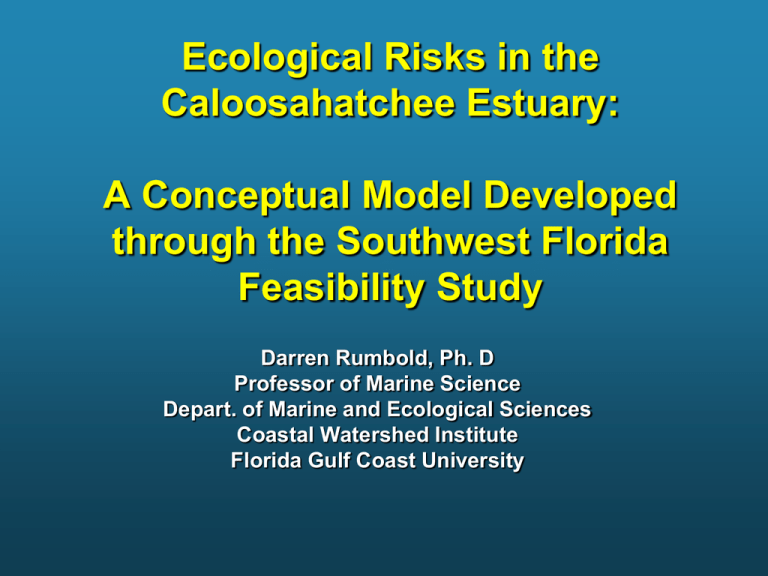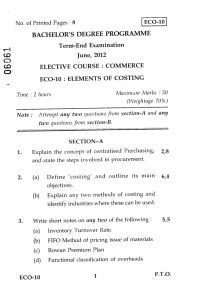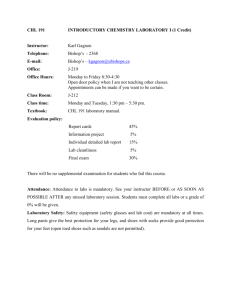Ecological Risks in the Caloosahatchee Estuary: A Conceptual Model Developed through the Southwest Florida Feasibility Study
advertisement

Ecological Risks in the Caloosahatchee Estuary: A Conceptual Model Developed through the Southwest Florida Feasibility Study Darren Rumbold, Ph. D Professor of Marine Science Depart. of Marine and Ecological Sciences Coastal Watershed Institute Florida Gulf Coast University Southwest Florida Feasibility Study (SWFFS) Purpose and Relationship to Comprehensive Everglades Restoration Plan (CERP) and Critical Projects The Restudy recommended a separate Comprehensive watershed study for Southwest Florida with the following purposes • Health of aquatic ecosystems • Water flows • Water quality (including appropriate pollution reduction targets) • Water supply (Lower West Coast Water Supply Plan) • Flood damage reduction • Wildlife and biological diversity • Natural habitat • Recreation (opportunity) Barnes, 2005 Benefits of Developing Conceptual Models? • The process of creating a conceptual model is a powerful learning tool. • Conceptual models are easily modified as knowledge increases. • Conceptual models highlight what is known and not known and can be used to plan future work. • Conceptual models can be a powerful communication tool. They provide an explicit expression of the assumptions and understanding of a system for others to evaluate. • Conceptual models provide a framework for prediction and are the template for generating more risk hypotheses. Barnes, 2005 Drivers • Sea Level Rise • Water Management • Land Use & Management • Maintaining Navigation Stressors • Altered Estuarine Salinity • Altered Hydrology • Input & Elevated Levels of Nutrients, Dissolved Organics & Toxins • Boating & Fishing Pressure • Physical Alteration to Estuary Altered Salinity Regime • While estuarine species are generally well adapted to cope with varying salinity conditions, larger shifts and timing of freshwater discharges can be a problem. – impacts the community structure and function of phytoplankton, submerged aquatic vegetation (SAV), macroalgae, benthos- particularly oysters and fisheries • Secondary, or indirect, effects on manatee demographics and wading bird community structure Important to Clearly Identify and Communicate Cascading Adverse Effects • Primary, or direct, effects: – occur when a stressor acts directly on the assessment endpoint and causes an adverse response • Secondary, or indirect, effects: – occur when the entity’s response becomes a stressor to another entity – are often a series of effects among a diversity of organisms and processes that cascade through the ecosystem – may have greater ecological significance than primary effect Increased Nutrients & Contaminants • Biostimulants, e.g., inorganic and organic nutrients, influence growth and community structure of phytoplankton, macroalgae, and microbes. – Indirect effects on SAV, zooplankton, fish and other aquatic organisms from: 1) light attenuation, 2) altered dissolved oxygen concentrations, and 3) biotoxins • which, in turn, can have cascading effects on manatee, dolphins and wading bird community structure Cloern 2001, Marine Ecology Progress Series Table 1. Summary of findings of water quality assessments in the Caloosahatchee Estuary, San Carlos Bay, Pine Island Sound and Matlacha Pass. Waterbody Upper Caloosahatchee (WBID 3240C) Middle Caloosahatchee (WBID 3240B) Lower Caloosahatchee (WBID 3240A) Doering and Chamberlain, 1998a Chl a>11 ug/L TP>state median TN>state median DO<WQS Color rel. high Chl a>11 ug/L TN > state median TN>state median Janicki Environ. Inc., 2002b Chl a>ref. site, IWR TN>ref. site TP>historic, ref. site DO<historic, ref. site, IWR Turbidity>histori c Chl a>ref. site, IWR TN>ref. site TP>ref. site DO<ref. site, IWR Turbidity>ref. site Chl a>ref. site, IWR TN>ref. site TP>historic, ref. site DO<historic, ref. site, IWR Turbidity>histori c FDEP, 2002; 2003c Impaired for: Chl a, DO, coliform Impaired for: Chl a, DO, copper, coliform Impaired for: Chl a, DO, copper, lead, biology ERD, 2003d Strong gradient with decreasing conc. of most constituents with increasing dist. from S79; Chl a>11 ug/L DO<WQS Spike in downstream gradient in ammonia, TKN, TN and Chl a. Chl a>11 ug/L Mean DO>WQS Janicki Environ Inc., 2003e Tetra Tech, Inc., 2004f Unaccept. based on informal IWR: Chl a, DO, coliform; trend of declining WQ in BOD, TSS, nutrients, secchi depth Decreasing trends in DO, increasing trends in turbidity, potassium and TN; Improvements in TP; Water of Concern: Fecal Coliform, DO, unionized ammonia (tribs), nutrients, iron, copper, conductance (tribs) Unaccept. based on informal IWR: Chl a, DO, coliform; trend of declining WQ in BOD, TSS, nutrients, secchi depth Decreasing trends in DO, increasing trends in turbidity, BOD, TSS; mixed trends in TP; Water of Concern: Fecal Coliform, DO, unionized ammonia (tribs), nutrients, iron, copper Unaccept. based on informal IWR: Chl a, DO, coliform; trend of declining WQ in BOD, TSS, nutrients, secchi depth Decreasing trends in DO, increasing trends in turbidity, TSS, nitrite+nitrate, BOD, TP, and fecal coliform; mixed trends with TNand TKN, Water of Concern: Fecal Coliform, DO, nutrients, iron, copper, conductance (tribs) Table 1. Continued. Waterbody Doering and Chamberlain, 1998a Janicki Environ. Inc., 2002b FDEP, 2002; 2003c ERD, 2003d San Carlos Bay (WBID 2065H) Chl a rel. low TN>state median DO rel. high Turbidity rel. low; TSS > state median Pine Island Sound (WBID 2065E and G) Chl a rel. low TN>statewide median DO rel. high TSS>state median Matlacha Pass (WBID 2065F) Chl a rel. low TN>state median DO rel. high not assessed No listed impairment not assessed SW coast not assessed not assessed Mercury not assessed not assessed not assessed No listed impairment Impaired for: bacteria (in shellfish) Chl a<11 ug/L Mean DO>WQS not assessed Janicki Environ Inc., 2003e Tetra Tech, Inc., 2004f Assessed under Matlacha Pass DO, turbidity trends not assessed; Accept. based on informal IWR; exceedances in ammonia and DO at some stations Accept. based on informal IWR; improving trends in secchi depth and TN Decreasing trends in DO; Water of Concern: Fecal Coliform, DO (Sanibel), nutrients (St James City) Decreasing trends in DO, increasing trends in turbidity Water of Concern: Fecal Coliform, DO (Gator Slough) Water of Concern: nutrients Increased Nutrients & Contaminants • Toxicants, both metals and organics (e.g., pesticides, pharmaceuticals and personal care products) could be having insidious effects on individuals (e.g., immunosuppression, behavior, etc.) populations and community structure. – Loss or contamination of prey can have indirect effects on fish and wildlife predators (e.g., sharks, dolphins, birds), as well as human consumers Input parameters might include: water-column BOD, COD; sediment oxygen demand; adsorption coeff., particle-size distribution, settling coeff.; rates of nitrification, denitrification, mineralization and fixation; reaeration rate (SA/vol., temp., turbulence, stratification, algal growth, photosynthesis, respiration, settling rates; light avail. (note, inter-dependence). WQ PERFORMANCE MEASURE Parameter ; causal, response or both WQS; Component specific Basin e.g., C43, Tidal Caloosahatchee, Estero, and BCB Loading model Process model, Target Constraint Inflow v. outflow concentration e.g., ECOlab loads Empirical model, TSS; Turbidity DOC / DOM; TN (NOx + TKN); TP, SRP Historical-based, e.g., natural systems, OFW, etc. e.g., regression Reference site, BMP effectiveness as % reduction Process model, e.g., ECOlab Fraction of Freshwater Method, i.e., mass balance Input parameters will include: Land use Soils Topography Land use-specific event mean conc. Land use-sp. runoff coefficient Many other simplifying assump. Empirical model, e.g., regression e.g., 10K Island, 25th - 75th percentile for a given salinity regime Dissolved Oxygen; Chl-a; Color; Clarity / PAR Coordinate w/ Natural Systems Group Eco-resource, e.g., SAV, oysters, redfish; sawgrass Habitat Units, NEED TO CONNECT THE DOTs Output Scale ??? Instantaneous minimum ---Seasonal means Point - River segment - Spatially explicit e.g., acres, lbs, Catch per unit effort Cloern 2001, Marine Ecology Progress Series Simultaneous Effects of Multiple Stressors “The presence of multiple stressors may either increase or dampen the temporal and spatial variability seen in aquatic systems, depending on the interactions among stressors and the influence of background environmental conditions and sensitive species on the expression of stressor effects.” (Breitburg et al. 1999) Breitburg et al. 1999 Barnes, 2005 Take Home Message • Many people invested an incredible amount of time and energy in the SWFFS developing decision-support products such as the conceptual model • Although those products should serve as a strong foundation, they can be improved upon and expanded, especially the predictive models linking stressors with eco-resources • We are not under the same constraints as SWFFS and so can develop an analysis plan for research to fill data gaps, particularly on simultaneous effects of multiple stressors and indirect effects



